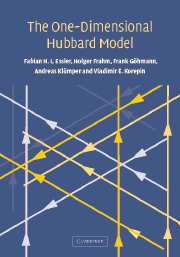Book contents
- Frontmatter
- Contents
- Preface
- 1 Introduction
- 2 The Hubbard Hamiltonian and its symmetries
- 3 The Bethe ansatz solution
- 4 String hypothesis
- 5 Thermodynamics in the Yang-Yang approach
- 6 Ground state properties in the thermodynamic limit
- 7 Excited states at zero temperature
- 8 Finite size corrections at zero temperature
- 9 Asymptotics of correlation functions
- 10 Scaling and continuum limits at half-filling
- 11 Universal correlations at low density
- 12 The algebraic approach to the Hubbard model
- 13 The path integral approach to thermodynamics
- 14 The Yangian symmetry of the Hubbard model
- 15 S-matrix and Yangian symmetry in the infinite interval limit
- 16 Hubbard model in the attractive case
- 17 Mathematical appendices
- References
- Index
8 - Finite size corrections at zero temperature
Published online by Cambridge University Press: 19 August 2009
- Frontmatter
- Contents
- Preface
- 1 Introduction
- 2 The Hubbard Hamiltonian and its symmetries
- 3 The Bethe ansatz solution
- 4 String hypothesis
- 5 Thermodynamics in the Yang-Yang approach
- 6 Ground state properties in the thermodynamic limit
- 7 Excited states at zero temperature
- 8 Finite size corrections at zero temperature
- 9 Asymptotics of correlation functions
- 10 Scaling and continuum limits at half-filling
- 11 Universal correlations at low density
- 12 The algebraic approach to the Hubbard model
- 13 The path integral approach to thermodynamics
- 14 The Yangian symmetry of the Hubbard model
- 15 S-matrix and Yangian symmetry in the infinite interval limit
- 16 Hubbard model in the attractive case
- 17 Mathematical appendices
- References
- Index
Summary
In this chapter we want to refine the analysis of the ground state and low-lying excitations of the Hubbard model in the phases with gapless modes, i.e. phases II, IV and V discussed in Chapters 6, 7, by taking account of corrections which are important when considering Hubbard chains of finite length L. For the generic case, i.e. away from half-filling in a magnetic field, the finite-size corrections to the spectrum of the Hubbard model have been calculated by F. Woynarovich [487]. These results are the basis for our discussion in the following Chapter 9 of the asymptotic behaviour of correlation functions within the conformal approach [6, 51, 62, 75] and thereby will allow us to make contact with Haldane's Luttinger liquid approach for the description of one-dimensional strongly correlated electron systems [189–192]
Generic case – the repulsive Hubbard model in a magnetic field
To investigate how the thermodynamic limit is approached we have to take into account finite-size corrections in our previous derivation of integral equations from Takahashi's equations. This analysis has to be performed separately for each of the phases with gapless excitations identified before. From a technical point of view the most complex situation is found in phase IV – the partially filled, partially magnetized band with two massless modes. The finite-size scaling behaviour in the phases with a single gapless mode can be studied using the same techniques and we will point out the differences to the ‘generic’ case studied in this section later in this chapter.
Information
- Type
- Chapter
- Information
- The One-Dimensional Hubbard Model , pp. 268 - 296Publisher: Cambridge University PressPrint publication year: 2005
